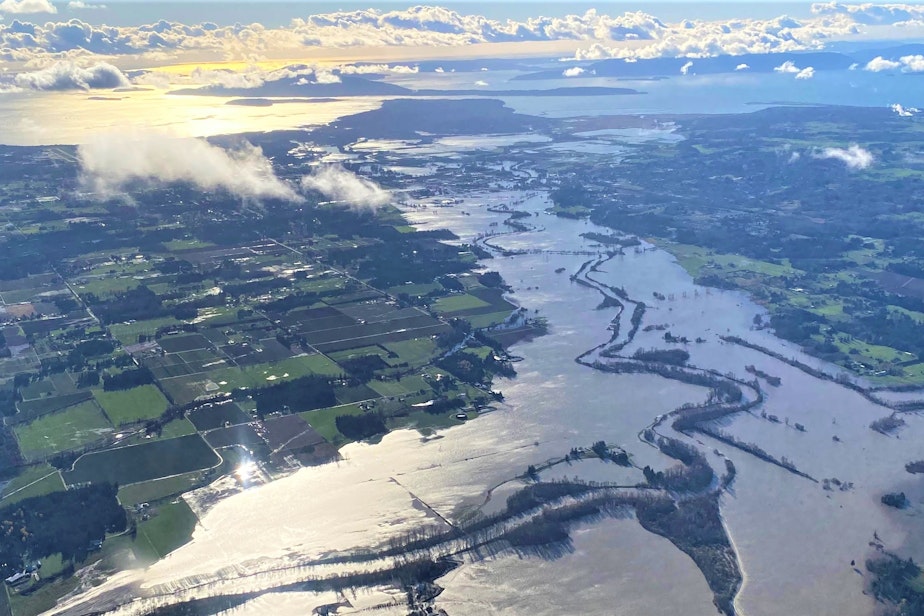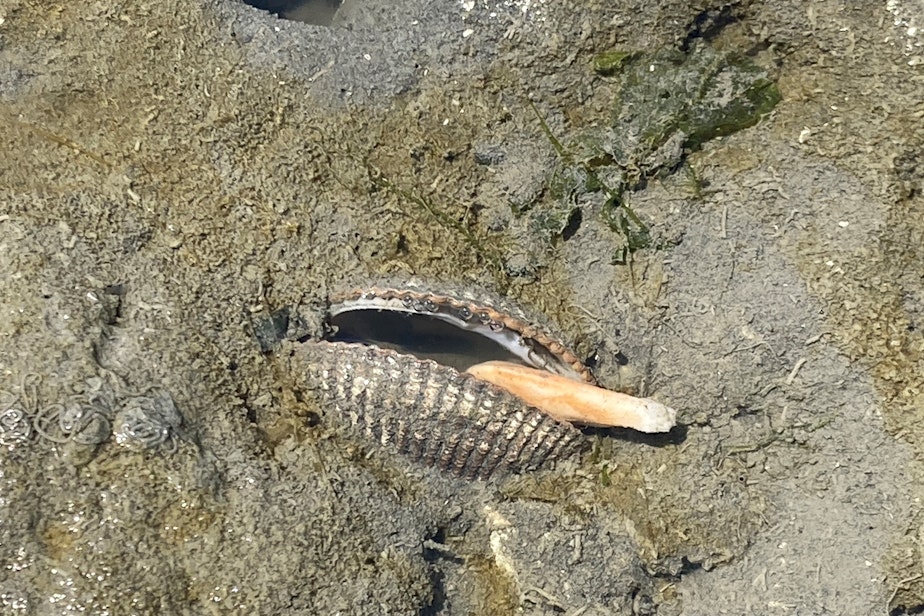For the Northwest, climate change was hard to ignore in 2021

2021 brought some of the most extreme weather events ever seen in the Pacific Northwest — or anywhere.
From heat domes to record-breaking rainfall, climate change was hard to ignore in Washington.
As temperature records shattered around the state in late June, the 911 calls poured in.
“Hi, I just drove past the Kenmore Park & Ride, and there was a person laying on the ground. It’s 102,” one caller told an operator on June 28, the hottest day recorded in the history of Washington state.
“We’ve been extremely busy everywhere because of the weather, so it could be quite a while before we get out there,” another 911 operator told a caller who had reported a middle-aged man passed out from the heat in a pet-store parking lot.
“I had to break down the door because we hadn’t been able to get a hold of her all morning,” a man in Burien reported after checking on a family member. “She’s laying on the ground. She’s ashen.”
As people struggled to cope with the heat, emergency rooms struggled to cope with a surge in patients. Hospital officials say the region was lucky that the summer’s most dangerous heat came during a lull in the Covid pandemic.
Sponsored
Emergency nurse Amy Leah Potter recalled working at Harborview Medical Center on June 28, when Seattle hit 108 degrees.
“I remember specifically speaking with one paramedic, and I asked him how bad it was out there,” Potter said. “He showed me where he had little burns on his knees from being on the ground, intubating. He said he was intubating about three times an hour.”
State officials say heat killed 157 people in Washington this summer, with most of the deaths occurring during the week-long heat dome beginning June 26.
But data from the Centers for Disease Control and Prevention suggests that those deaths were undercounted. A KUOW analysis of excess deaths during that week indicates the true number of extreme heat fatalities in Washington exceeds 400. Hundreds also died in Oregon and British Columbia.
In Washington, the record-smashing heat wave was the deadliest weather event in state history.
Sponsored
It was also the most extreme heat wave ever documented on planet Earth, weather historians say. Temperature records fell by wider margins over a wider area than anywhere else on record.
“That was so off the charts that I think a lot of us might not have expected quite that level of heat,” said Meade Krosby, a climate adaptation scientist at the University of Washington .
“It's something I might have expected to happen more mid-century.”
For years, climate scientists have emphasized the urgency of both eliminating heat-trapping pollution and preparing for what lies ahead.
“Our job right now is to slow it down as much as possible by lowering our greenhouse gas emissions as quickly as possible and preparing,” Krosby said. “There's so much work to be done to prepare our communities.”
Sponsored
Steve Mitchell, the medical director for Harborview's emergency department, said the heat wave "taught us some valuable but painful lessons in the process."
Hospitals started cooperating regionally and redirecting some emergency patients to prevent hospitals in harder-hit neighborhoods from being overwhelmed.
Recent actions in Congress and at the global climate talks in Scotland in November seem to indicate that national and world leaders haven't embraced the same lesson about cooperating to keep the planet’s climate livable.
A month before the heat wave, Washington Gov. Jay Inslee signed a sweeping set of laws aimed at reducing the state’s greenhouse gas emissions.

Sponsored
Climate disasters affect everyone, but they tend to hit poor communities and communities of color the hardest — along with the species they rely on.
Hundreds of millions of shellfish baked to death in the mud as an extremely low tide coincided with extremely high temperatures.
On south Puget Sound, the Squaxin Island Tribe depends heavily on species like butter clams and manila clams.
From exposure to triple-digit temperatures in one afternoon, “we'll see approximately a 30% loss in those species,” said Candace Penn, the tribe’s climate change ecologist.
Losses of shellfish and salmon cut deep for many Northwest tribes.
Sponsored
“I like to think of the species that we consume, or some of our first foods, as an extension of our tribe, or an extension of our beings,” Penn said.
She said that’s a big part of why the tribes work hard to keep fish and shellfish from disappearing.
Penn said that if they were to fail at that task, “it would probably feel like, much like, a death or a funeral because we lost a piece of us.”
Penn said she avoids despair by focusing on the good work being done to help people and nature cope.
“We can actually do something about this if we look closely, and if we think about it,” she said.
The Squaxin Island Tribe is looking to expand its aquaculture operations into deeper waters that are less exposed to heat waves with species like geoduck.
A lesson climate adaptation experts preach: Healthier ecosystems are better able to withstand the insults that an increasingly hostile climate might throw at them.
Penn said the Squaxin Island Tribe is still able to eat shellfish and salmon from its waters because the habitat is protected and the waters are clean.
“We have worked very hard to keep it that way,” Penn said.
Flooding across the Northwest
Bellingham, Seattle, and the Olympic coast all had their rainiest autumns on record in 2021. The flooding that followed cut off towns and Indian reservations from the outside world.
The losses were most severe just to the north, in British Columbia, where the 500-year floods killed four people and more than 600,000 farm animals and did an estimated $7 billion in damages.
For Whatcom County, the flooding was the costliest disaster in the county’s history.
Gov. Inslee and the state’s Congressional delegation are seeking federal disaster aid for Whatcom, Skagit, and Clallam counties and for the Lummi, Nooksack, and Quileute tribes.
Activist Rosalinda Guillen with Community to Community in Bellingham said floodwaters displaced large numbers of farmworkers and their families who lived in mobile homes and substandard housing.
About 800 homes in Whatcom County were hit by floodwaters. As of mid-December, about 200 evacuees were still sheltering in motels and other temporary housing.
“Why are there mobile homes and housing placed in floodplain areas where the flooding happens all the time?” Guillen asked. “We've seen these floods here before. They've never been this bad, but it's always flooded.”
“This year and last year has been very difficult for farmworkers in rural areas,” Guillen said. “You've got Covid that we have to deal with, then the heat dome, and now we have the flooding.”
Guillen’s group is calling on Whatcom County to provide better emergency housing than a labor camp in Sumas built for individual migrant workers, where about 30 evacuees have been staying.
County officials say each family at the Sarbanand Farms facility in Sumas has its own bunkhouse.
“We’re just trying to put folks in a warm place to stay until they can move out and move on,” Whatcom County spokesperson Jed Holmes said.
“Skagit and Whatcom counties have extremely low rental vacancy rates, which will make finding an affordable and available home in the area enormously challenging for the hundreds of individuals displaced by this disaster,” Inslee said in his aid request to the Federal Emergency Management Agency.
Northern Washington and much of British Columbia had to endure a gauntlet of climate-fueled disasters this year, one after the other: heat, wildfires and their smoke, and flooding rivers — all in the midst of a global pandemic.
Meade Krosby said that’s the thing about climate change: It doesn’t wait around until nothing else is going on. Tackling it will require learning how to solve multiple problems at the same time.




